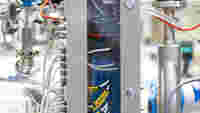Promoting Digitalization in the Process Industry with Open Interfaces

Data is essential for innovations in the process industry. When it is available, all of the advantages offered by digitalization can be utilized, new approaches can be tried, and processes can be optimized and made more efficient. Up until now, companies have lacked this possibility, because process information is difficult to access from the manufacturer-specific systems in which it is immured. An Industry 4.0 demonstration and test system in the Höchst Industrial Park solves this problem. Here, data is exported through an open interface into the system world, so that it can be freely used for monitoring and optimization tasks.
Your benefits with WAGO:
Automation based on the “NAMUR Open Architecture” concept
HART sensor readout via OPC UA, independent of the process channel for the process control
HART, PROFIBUS DP, Modbus® and OPC UA communication in one controller



